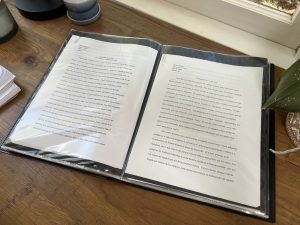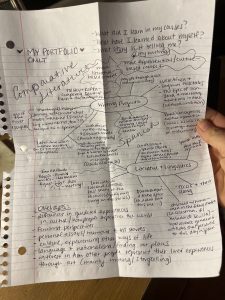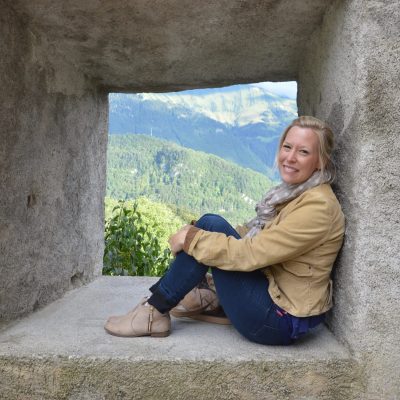13 What My ePortfolio Was Telling Me
Kristin Winet
This is a story about two frogs who lived in Japan. One day, the frogs decide to embark upon a journey to see the other one’s city. They meet on top of a mountain and decide to try and see what lies ahead by holding hands and standing up on their hind legs. “Your city looks just like my city,” one says, disappointed. “And yours, like mine,” says the other. They decide to go back home and never travel again.
What the frogs forgot, though, is that their eyes are in the backs of their heads. When they stood up to see what was in front of them, they were actually looking backwards. The Japanese teach this story as “everything is not as it seems,” but I’ve always had a different take on the tale.
I have a bookshelf in my living room that is filled with my hand-written journals. Unlike the frogs, the journals have had a beautiful and well-traveled life: their bindings are worn, they are stained with coffee and smudged ink, and the pages smell like sand and dust. Inside, each one is filled with names and dates and the origins of stories scribbled in airports and at cafés and in the back of taxis.
At the other end of the shelf is a small black book with plastic sleeves that has never left my living room. It is my college portfolio, and I keep it there because if I had never made that portfolio, I would have never become a travel writer.

Of course, the girl who once sat cross-legged on the floor of her apartment in Athens, Georgia, holding a box of everything she’d written for the past two years, would have no way of knowing how important this portfolio would be in her life. In the moment, I simply turned the box over and watched a jumble of papers fall out. What do all of these essays have in common? Why did I, suburban girl from the American south, choose a major like Comparative Literature?
I smoothed the essays into a half-circle on the floor so I could see them all at once: An analysis about sorghum in Malian creation myths for Dr. Traore’s oral storytelling course; a profile about a Brazilian berimbau player for Dr. Kidula’s class on ethnomusicology; an essay about trying to meditate after reading The Way of Zen for Dr. Benedek’s East Asian seminar; a memoir for Dr. William’s creative writing workshop about attending a festival in Spain where they set giant satirical papier-mâché statues on fire every spring; an essay about why papaya is such a popular word in Costa Rican idioms for Dr. Sarmiento’s linguistics course.
In my first two years of college, I had switched majors five times until I took a course on ethnic American women writers and fell in love with the way the professor, who told us she was from a department called Comparative Literature, taught us to analyze books from the lens of a cultural anthropologist. I declared my sixth major and devoted the next two years to learning how to do what she did: I became the first person in my family to get a passport and studied in Spain and then Malta, and I’d taken a messy web of interdisciplinary, cross-listed classes that taught me to understand how — and by whom — our stories are told.
On a piece of paper, I drew loops and arrows between my essays, looking for the thread that would connect them. I thought about the never-ending loop of discovery, the joy of researching places I had to look up on maps, the curiosity that compelled me to ask people to tell me their stories, the fascination I felt when I read how people understood love, or the stars, or history. The kinetic energy I felt every time I looked at the next semester’s schedule of classes, imagining myself immersed in Zulu, or Japanese mythology, or the diaries of Lady Montagu.

It wasn’t just the tiptoeing into other cultures I loved — it was the writing I did, too. In one essay, I had interviewed someone whose talent I wanted to understand; in another, I had researched food traditions and cultural histories and saw how they impacted language and myth. I had grappled with how to write about a place without using words like “exotic” and “hidden gem.” What did the best travel writers do if not interview, research, describe, and challenge what we think we know? That afternoon, I marched my portfolio over to campus, headed to the library, and decided I’d spend a year teaching abroad and learning to write about the things I had studied.
A few months later, I sat on my childhood bed and set up my first blog while I waited for my visa to come back from the Colombian embassy. I wrote a hundred stories on that blog and loved every second. A year later, I moved to Arizona to study creative writing and find out what travel writers actually did. Five years after that, I rode around on the back of a motorcycle with a Canadian photojournalist on my first press trip and learned how to find stories in everyday objects like a piece of jade carved into the shape of a cabbage. After documenting some of these objects in my travel journals, I spent hours writing query letters, learned the art of rejection, and figured out how to turn one trip into 10 stories.
Today, I look at where I am — a writer and a teacher with two young children who somehow found her way back to the Sonoran Desert, a map on her wall full of pins from the places she’s been — and I wonder: Is there anything I would tell the 22-year-old sitting on the floor that day?
I would tell her, I think, that the frogs got it all wrong. They looked back and thought nothing better awaited them.
Look back, I’d tell her, check your compass, and keep walking.


